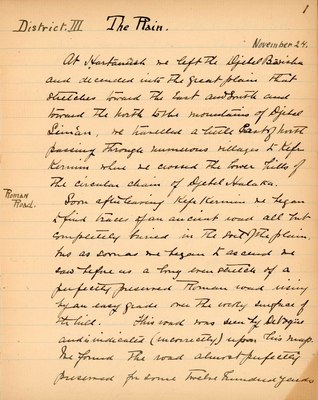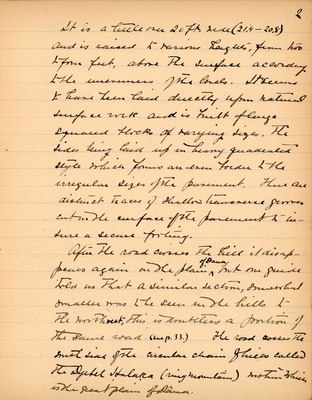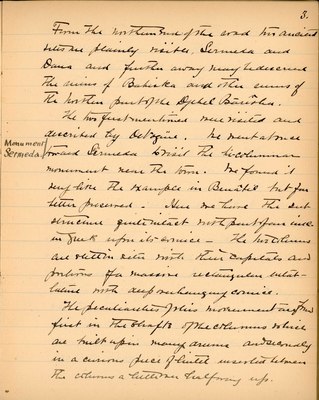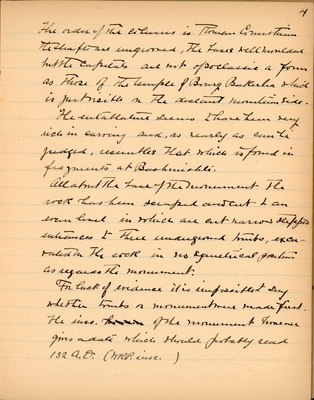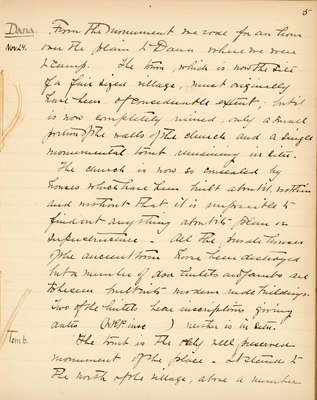Pages
BSY_FB_15-01
1
District III. The Plain.
At Ḥartanūsh we left the Djebel Bārîsha and descended into the great plains that stretches toward the East and South and toward the North to the mountains of Djebel Simʿan, we travelled a little East of North passing through numerous villages to Kefr Kermîn where we crossed the lower hills of the circular chain of Djebel Ḥaluḳa.
Roman Road. Soon after leaving Kefr Kermîn we began to find traces of an ancient road all but completely buried in the soil of the plain, but as soon as we began to ascend we saw before us a long even stretch of a perfectly preserved Roman road rising by an easy grade over the rocky surface of the hill. This road was seen by DeVogüé and is indicated (incorrectly) upon his map. We found the road almost perfectly preserved for some twelve hunded yards
BSY_FB_15-02
2
It is a little over 20ft wide (21.4 -20.8) and is raised to various heights,from two to four feet, above the surface according to the unevenness of the levels. It seems to have been laid directly upon natural surface rock and is built of large squared blocks of varying sizes. The sides being laid up in heavy quadrated style which forms an even border to the irregular sizes of the pavement. There are distinct traces of shallow transverse grooves cut in the surface of the pavement to insure a secure footing.
After the road crosses the hill it disappears again on the plain ^ of Dâna ^ but one guide told us that a similar section, somewhat smaller was to be seen in the hills to the northwest, this is doubtless a portion of the same road (see p.33). The road crosses the south side of the circular chain of hills called the Djebel Ḥaluḳa (ring mountain) within which is the great plain of Dâna.
BSY_FB_15-03
3.
From the northern end of the road two ancient sites are plainly visible, Sermedā and Dâna and further away may be described the ruins of Bābisḳa and other ruins of the northern part of the Djebel Bārîsha.
Monument Sermedā. The two first mentioned were visited and described by DeVogüé. We went at once toward Sermedā to visit the bi-columnar monument near the town. We found it very like the example in Benâbil but far better preserved. Here we have the sub structure quite intact with part of an insc. in Greek upon its cornice - The two columns are still in situ with their captials and portions of a massive rectangular entablature with deep overhanging cornice.
The peculiarities of this monument are found first in the shafts of the columns which are built up in many drums and secondly in a curious piece of lintel inserted between the columns a little over half way up.
BSY_FB_15-04
4
The order of the columns is Roman Corinthian the shafts are ungrooved, the bases well moulded but the capitals are not of a classic form as those of the temple of Bourg Baḳirhā which is just visible on the distant mountain side.
The entablature seems to have been very rich in carving and, as nearly as can be judged, resembles that which is found in fragments at Bashimishli.
All about the base of the monument the rock has been scraped and cut to an even level in which are cut narrow stepped entrances to three underground tombs, excavated in the rock in no symmetrical position as regards to the monument.
For lack of evidence it is impossible to say whether tombs or monument were made first. The inscription of the monument however gives a date which should probably read 132 A.D. (W.K.P. insc. [blank]).
BSY_FB_15-05
5
From the monument we rode for an hour over the plain to Dâna where we were to camp. The town, which is now the site of a fair sized village, must originally have been of considerable extent; but it is now completely ruined, only a small portion of the walls of the church and a single monumental tomb remaining in situ.
The church is now so consealed by houses which have been built about it, within and without that it is impossible to find out anything about its plan or superstructure. All the private houses of the ancient town have been destroyed but a number of door lintels and jambs are to be seen built into modern made buildings. Two of the lintels bear inscriptions giving dates [blank] (W.K.P. insc [blank]) neither is in situ.
Tomb. The tomb is the only well preserved monument of the place - It stands to the north of the village, above a number
